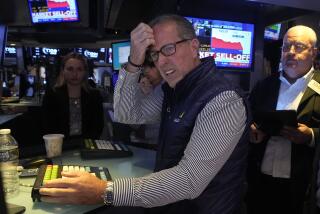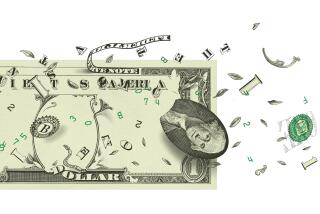On Wall St., Y2K Is Sand in Forecasting Machine
- Share via
Wall Street loves a good mystery when the potential payoff for guessing the outcome is significant.
But what to do about Y2K?
This event messes with the market’s mind in a big way. Financial markets, after all, are supposed to discount the future--that is, investors are supposed to price securities at any moment based on some reasonable assumptions about the economy, corporate earnings, interest rates, etc.
Discounting Y2K, however, means discounting something everyone knows about, but about which no one can be certain, because we’ve never been here before. It also means discounting people’s assumptions about how other people will react to their own assumptions.
Got it?
“Y2K throws a lot of sand into the gears of the market discounting mechanism,” says Douglas Cliggott, U.S. equity strategist at J.P. Morgan Securities in New York.
Indeed, investors who try to devise a strategy for either taking advantage of, or avoiding, Y2K-related fears can quickly find themselves on a course that leads everywhere and nowhere.
As the accompanying stories point out, trimming stock and bond investments in favor of building a bigger cash cushion in one’s portfolio seems to make sense, if you’re really worried about economic disruptions because of potential computer failures.
But if everyone has the same idea, and securities prices are about to dive in coming months, selling into such a decline ought to quickly become less appealing.
Moreover, assuming the world doesn’t end on Jan. 1 even if some computers lose their silicon minds, anyone selling today might be expecting to simply buy back into markets in early January. Except that, at that point, millions of other investors would probably have the same idea, and you would risk jumping into an upside market panic at inflated prices.
That could be particularly true in emerging-market stocks, where it doesn’t take much to move prices 20% in either direction.
For “contrarian” investors who would rather go counter to the actions of the masses, the logical strategy now would be to wait for others to dump securities in coming months and pick them up at cheap prices.
Yet that, too, poses a big challenge: How will you know when the bottom is reached? In the market for high-yield corporate “junk” bonds, for example, yields are already nearing their highest levels in five years as the bonds’ prices have declined. Are they attractive enough already--or should you wait for even better returns, understanding that they might not materialize?
Even if you’re confident about buying an investment that may be marked down by Y2K-related selling, there may be other considerations. If the investment is a mutual fund, for example, you’ve got to be aware of year-end capital gains payments, as my colleague Paul Lim notes in his column today. No point in buying an instant fund tax liability if you can avoid it.
Overshadowing all of these potential Y2K investment strategies is the strong possibility that any expenditure of effort in trying to calculate how things will work out could be a complete waste of your time.
Although there is a reasonable case to be made that some investors will flee higher-risk securities and markets in coming months, that is no more certain than any other prediction with regard to Y2K.
*
What if this all turns out to be the biggest yawner in Wall Street history? One can argue that we’re on course for exactly that outcome in most markets.
For example, while it does appear that corporate bond yields are higher today at least in part because of Y2K fears, neither the U.S. stock market nor most other world equity markets seem to be registering much in the way of Y2K concerns.
Consider the U.S. small-stock market. With less than 3 1/2 months to go before Jan. 1, you would expect by now to see some investors pulling out of volatile smaller shares rather than risk market turmoil as the calendar changeover nears.
But Standard & Poor’s index of 600 smaller stocks has essentially gone nowhere in recent weeks, and is down just 5.8% from its 1999 high set in mid-July.
That’s only a slightly worse haircut than the blue chip Dow Jones industrials, at 10,803 on Friday, have taken from their August record high. (U.S. blue chips, remember, ought to be the stocks of choice if people are going to flee other equities for safer havens.)
Won’t some investors leave financial securities entirely and buy gold instead, as the ultimate hedge against trouble?
“Ignore the skeptics. Y2K could unleash a financial calamity even if the millennium change passes without a glitch,” screams the Louisiana-based Gold Newsletter in a flyer aimed at luring subscribers.
“As you know, the Y2K cyber meltdown will help reignite gold . . ,” it confidently states.
Not so far, that’s for sure: Gold futures contracts in New York, at $255 an ounce now, are no higher today than they were in early July.
And for the year to date, you would have been much better off buying aluminum or zinc than gold, if you absolutely had to put some metal in your portfolio.
*
Ironically, perhaps, one of the biggest problems Wall Street has with Y2K is that it’s too certain--that is, the date of the feared event is certain.
Betting on an economic recovery, or an economic recession, is an open-ended proposition. No one can be sure exactly when a recovery will begin, or when a recession will begin. They are moving targets.
Even with Federal Reserve policy meetings, after one meeting has passed, and the Fed has raised interest rates, cut them, or done nothing, there’s always the next Fed meeting to look forward to with hope or with loathing.
But Y2K is one date, then it’s over. Everything that goes wrong, if anything does, will be immediately evident to everyone. And then what?
Many Wall Street pros, having done mental calisthenics for months over Y2K, arrive at the same conclusion: If the world isn’t going to end on Jan. 1, one’s basic investment strategy today has to look beyond New Year’s Day. Anything you do before then, if Y2K-related, should be viewed as short-term speculation within what is (hopefully) a well-thought-out longer-term investment plan.
At J.P. Morgan, Doug Cliggott’s longer-term plan now is centered on this idea: The global economy is getting stronger. That has good implications for earnings growth at many companies here and abroad (a good reason to keep a big chunk of your portfolio in stocks).
It also has potentially bad implications for interest rates--a good reason to be cautious about bond investments. That doesn’t mean you don’t buy, or own bonds--just that you understand the possible ramifications of rising market rates if economic strength worldwide is even greater than expected in 2000.
Tom Petruno can be reached by e-mail at [email protected]
A note on my Sept. 5 column: Reader Tom Hickey points out that Teledyne Inc. in the 1980s may have been the third-highest-priced stock on the New York Stock Exchange instead of the second. I forgot Superior Oil.
More to Read
Inside the business of entertainment
The Wide Shot brings you news, analysis and insights on everything from streaming wars to production — and what it all means for the future.
You may occasionally receive promotional content from the Los Angeles Times.










